Europe Green Cement Market Size
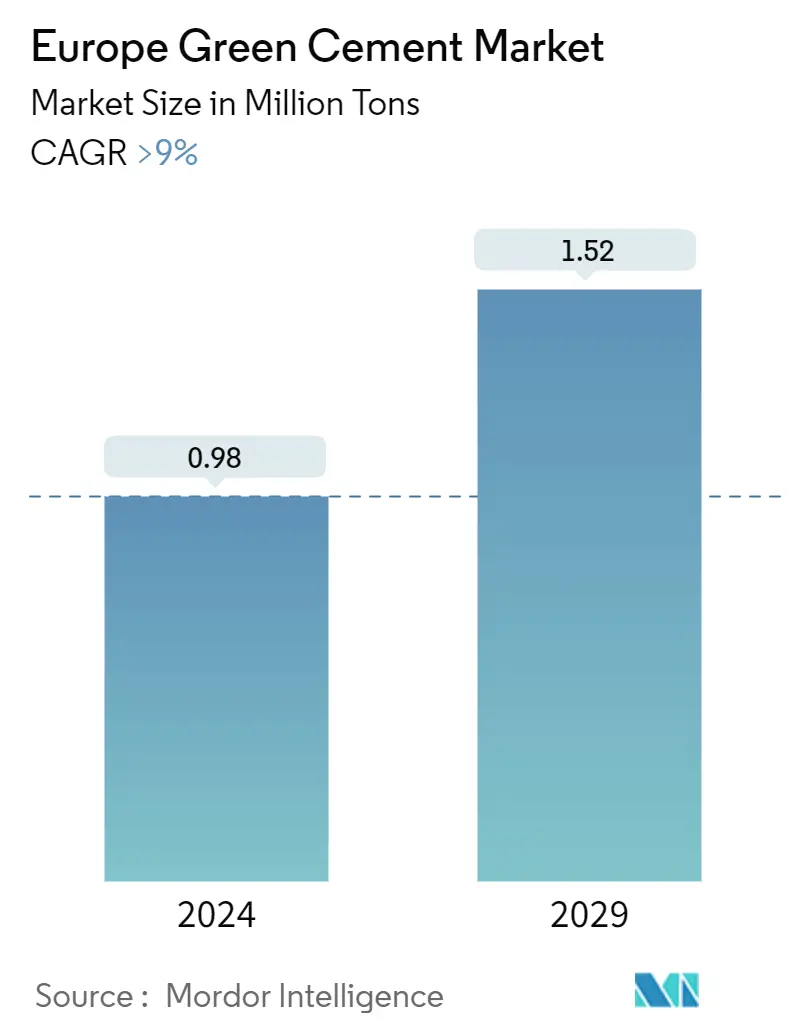
| Study Period | 2019-2029 |
| Base Year For Estimation | 2023 |
| Forecast Data Period | 2024 - 2029 |
| Historical Data Period | 2019 - 2022 |
| CAGR (2024 - 2029) | 9.00 % |
| Market Concentration | High |
Major Players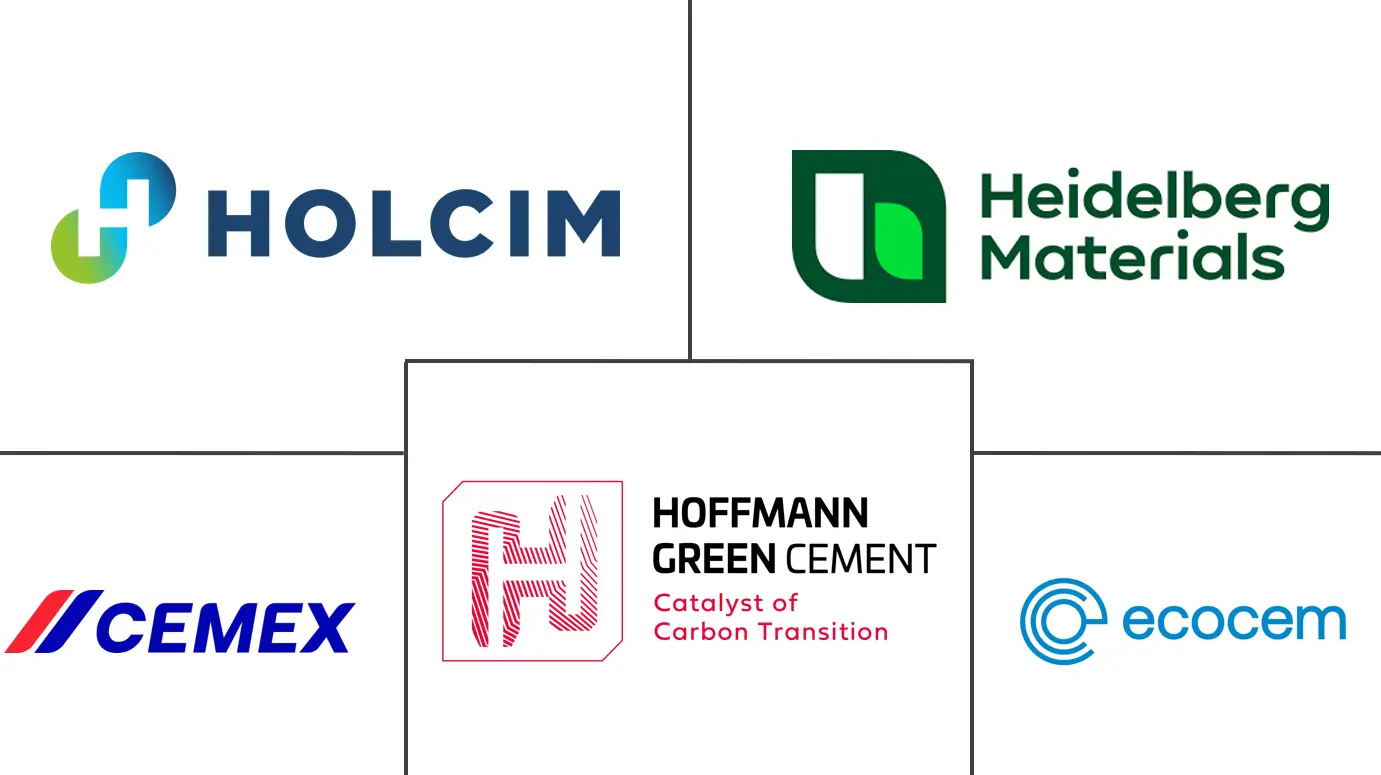
*Disclaimer: Major Players sorted in no particular order |
Europe Green Cement Market Analysis
The Europe Green Cement Market size is estimated at 0.98 Million tons in 2024, and is expected to reach 1.52 Million tons by 2029, growing at a CAGR of greater than 9% during the forecast period (2024-2029).
The COVID-19 pandemic in 2020 affected several industries negatively. The lockdown in most European countries caused construction activities to slow down, leading to reduced demand for green cement in the region. The green cement market's conditions started to recover in 2021 as the vaccination rates were increased and multiple government restrictions were lifted.
Over the short term, growth in sustainable projects in major economies like Germany, France, the United Kingdom, and Italy, favorable government policies for the usage of green cement, and availability of raw materials are major factors driving the growth of the market studied.
However, the rising cost of construction is likely to restrain the growth of the studied market.
Nevertheless, research and development of novel products as raw materials for green cement will likely create lucrative growth opportunities for the global market.
Germany represents the largest market over the forecast period due to the increasing adoption of green cement in its construction projects.
Europe Green Cement Market Trends
Residential Construction to Dominate the Market
- The European Union (EU) has set a target of reducing buildings’ greenhouse gas emissions by 60% by the end of 2030. The EU further plans to ensure the buildings are fully decarbonized by 2050.
- The European Commission has announced a renovation wave to improve the energy performance of buildings across the European Union. The goal is to double renovation rates by 2030, renovating 35 million buildings and creating up to 160,000 new green jobs in the construction sector. The European Commission aims to ensure energy and resource efficiency through the construction of green buildings.
- According to the Italian National Building Association (ANCE), to meet the goals of the European green building pact, 1.8 million residential buildings will have to be upgraded over the next ten years until 2033 at a cost of EUR 400 billion (~USD 439.29 billion).
- According to their estimates, a further EUR 190 billion (~USD 208.66 billion) will be needed to bring commercial properties to the required standards. In February 2023, Italy struck a deal with the European Union to use EUR 15.3 billion (USD 16.80 billion) from a post-COVID-19 EU recovery fund to improve the energy efficiency of buildings.
- According to the Office for National Statistics, in the United Kingdom, the construction of 118,410 residential units started in 2022. The number of completed projects stood at 104,680 units. These figures are promising as the construction activities in the country have risen to pre-pandemic levels.
- The French government's initiatives to develop the city for hosting the 2024 Olympics will likely drive the market. For instance, the French government sanctioned approximately USD 3.3 billion to construct the Hermitage towers (two 320-meter-1050-foot), which are due to be completed by 2024. The essential infrastructure for the Olympic event requires building 4,500 new dwellings for local people, 100,000 square meters for business activities, and 20,000 new hotel rooms for tourists.
- Courtesy of the growing empasis on the construction of green buildings in the region, the demand for green cement shall remain strong in the forecast period in the residential construction sector.
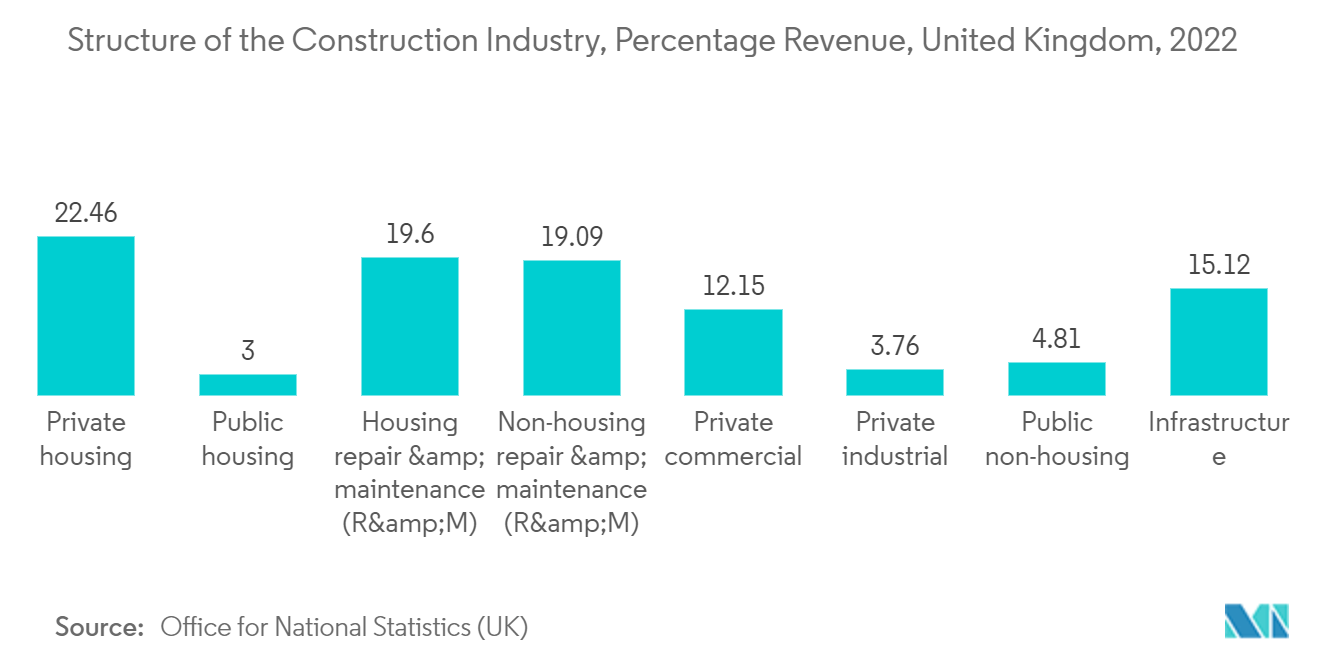
Germany to Dominate the Market
- According to the European Construction Industry Federation, the new construction order value in Germany in 2022 was EUR 99 billion (USD 107.72 billion), 4.8% more than that of 2021.
- According to the German Federal Statistical Office, the number of building permits in residential construction was 354,403 in 2022. A total of 68,700 residential building licenses were issued from January to March 2023, a decrease of 25.7% from the same period in the previous year (January to March 2022: 92,500 building permits). The drop in construction projects is most likely being caused by the high cost of building materials and the aftereffects of the Russia-Ukraine Crisis.
- However, the construction of hotels in Germany is expected to witness a sharp rise during the forecast period. The year 2022 saw the launch of 89 new hotels and 15,780 rooms. 78 more projects with 13,073 keys have been mooted for 2023. According to Hospitality Investor, as of Q3 of 2023, a total of 201 new hotels representing 32,889 rooms had been in the pipeline. The hotel construction project pipeline is anticipated to stay strong for 2024 and beyond, with 153 projects and 22,769 rooms already in the works.
- The German government plans to build 400,000 new apartments a year, of which 100,000 are to be publicly subsidized. The majority of these apartments are a part of the country's goal of being climate-neutral by 2045. The figures are more than 50,000 units higher than the current goal and 100,000 more than the construction industry has managed to build in 2022.
- According to the Federal Environment Agency, buildings in Germany emitted a total of 115 million tons of greenhouse gases in 2022, 3.3% less than in 2021. However, the sector continues to fall short of the federal government’s annual savings target of 113 million tons of carbon dioxide.
- The government has been pushing to meet the target of being carbon-neutral by 2045 by improving the policies that will add to the demand for green cement in the country.
- Thus, Germany is expected to maintain its dominance in the demand for green cement in Europe.
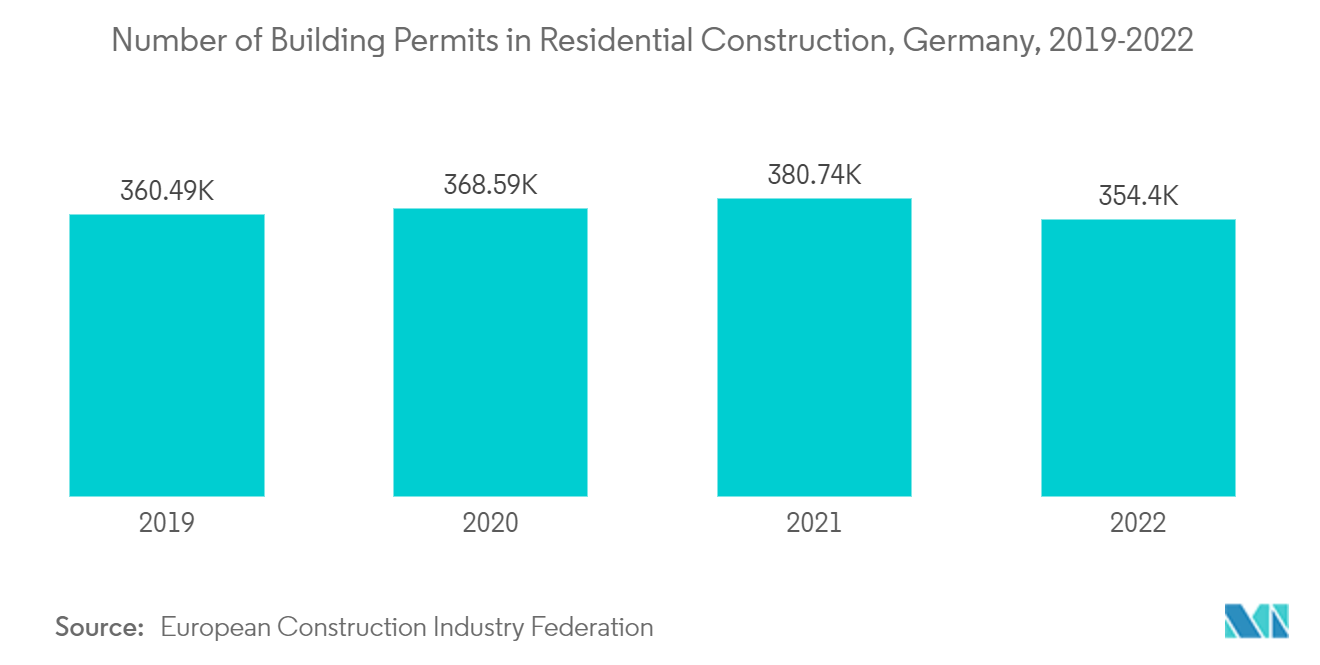
Europe Green Cement Industry Overview
Europe's green cement market is partially consolidated in nature. The major players (not in any particular order) include HOLCIM, Hoffmann Green Cement Technologies, CEMEX, S.A.B. de C.V., Heidelberg Materials, and Ecocem, among others.
Europe Green Cement Market Leaders
-
Hoffmann Green Cement Technologies
-
Ecocem
-
CEMEX, S.A.B. de C.V.
-
HOLCIM
-
Heidelberg Materials
*Disclaimer: Major Players sorted in no particular order
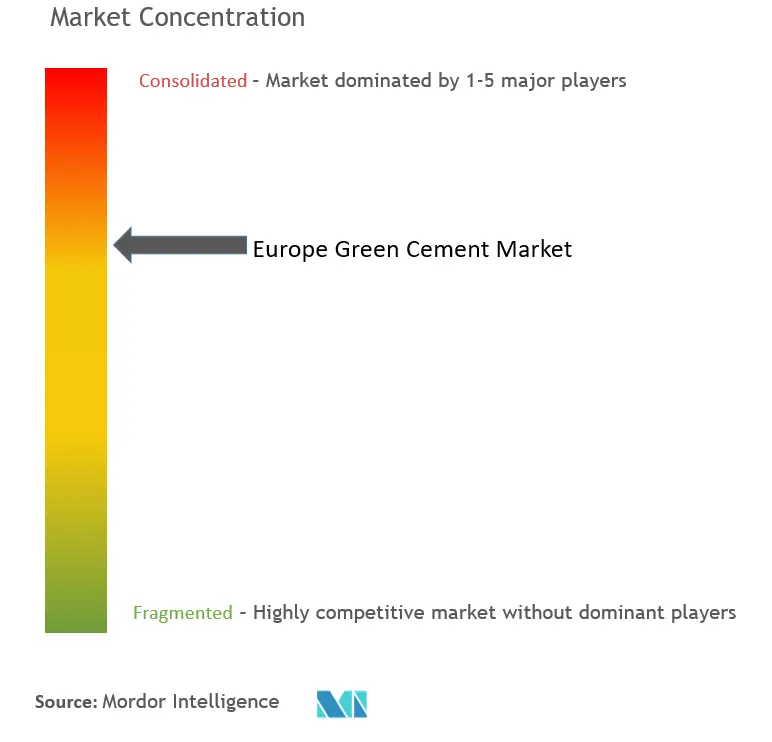
Europe Green Cement Market News
- January 2024: Hoffmann Green Cement Technologies announced the signing of a partnership to sell its clinker-free, low-carbon cement targeting the BtoC market through the retail network of Bricomarché, Bricorama, Brico Cash, and Tridôme (part of Les Mousquetaires Group).
- November 2023: Heidelberg Materials introduced the world’s first carbon-captured net-zero cement under its new evoZero brand to customers in Europe. evoZero achieves its net-zero footprint through the application of carbon capture and storage technology at the Heidelberg Materials plant in Brevik, Norway, without compensation from credits generated outside the company’s value chain.
- September 2023: Fortera Corporation aimed to fire up as many as seven commercial plants in the next five years with USD 1 billion in financing to fund its aggressive expansion.
- June 2023: Buzzi S.p.A., through the fully owned subsidiary Dyckerhoff GmbH, reached an agreement to sell some of its businesses in Eastern Europe to CRH, a leading building materials solutions company, for a consideration of €0.1 billion (approx. USD 108 million). The transactions included the business in Ukraine and ready-mix concrete assets in East Slovakia. In Ukraine, Buzzi operates two integrated cement plants located close to Rivne and Mykolaiv.
- May 2023: Hoffmann Green Cement Technologies commissioned its H2 plant adjacent to its existing H1 clinker-free cement plant in Bournezeau, Pays de la Loire. The production unit took two years to construct with an investment of EUR 22 million (USD 24.16 billion) and has a production capacity of 1000 tons per day of clinker-free cement. The company's clinker-free cement had over 90% lower carbon dioxide emissions than ordinary Portland cement.
- July 2022: Holcim signed an agreement with Ol-Trans to acquire its five concrete plants. The acquisition was to strengthen Holcim's local ready-mix concrete network and establish its pole position in Northern Poland. This transaction was expected to also increase the company's sales of ECOPact green concrete, which has up to 50% lower carbon footprint in Poland.
- April 2022: CEMEX, S.A.B. de C.V. invested in Carbon Upcycling Technologies, a solution that enables the reduction of carbon emissions in cement and concrete production by up to 30% through clinker substitutes. The technology was to help scale the company’s capability to reduce clinker in its cement production process.
Europe Green Cement Market Report - Table of Contents
1. INTRODUCTION
- 1.1 Study Assumptions
- 1.2 Scope of the Study
2. RESEARCH METHODOLOGY
3. EXECUTIVE SUMMARY
4. MARKET DYNAMICS
-
4.1 Drivers
- 4.1.1 Growth in Sustainable Projects in Europe
- 4.1.2 Favorable Government Policies for Green Building Construction
- 4.1.3 Abundance of Availability of Raw Materials
-
4.2 Restraints
- 4.2.1 Rising Construction Costs
- 4.2.2 Other Restraints
- 4.3 Industry Value Chain Analysis
-
4.4 Porter's Five Forces Analysis
- 4.4.1 Bargaining Power of Suppliers
- 4.4.2 Bargaining power of Buyers
- 4.4.3 Threat of New Entrants
- 4.4.4 Threat of Substitute Products and Services
- 4.4.5 Degree of Competition
5. MARKET SEGMENTATION (Market Size in Volume)
-
5.1 Product Type
- 5.1.1 Fly Ash-based
- 5.1.2 Slag-based
- 5.1.3 Limestone-based
- 5.1.4 Silica fume-based
- 5.1.5 Other Product Types (Geopolymers and Recycled Aggregates)
-
5.2 Construction Sector
- 5.2.1 Residential
- 5.2.2 Non-residential
-
5.3 Geography
- 5.3.1 Germany
- 5.3.2 United Kingdom
- 5.3.3 France
- 5.3.4 Spain
- 5.3.5 Russia
- 5.3.6 NORDIC
- 5.3.7 Italy
- 5.3.8 Turkey
- 5.3.9 Rest of Europe
6. COMPETITIVE LANDSCAPE
- 6.1 Merger & Acquisitions, Joint Ventures, Collaborations, and Agreements
- 6.2 Market Share Analysis (%)**/Ranking Analysis
- 6.3 Strategies Adopted by Leading Players
-
6.4 Company Profiles
- 6.4.1 Cementir Holding N.V.
- 6.4.2 CEMEX, S.A.B. de C.V.
- 6.4.3 CRH
- 6.4.4 Dyckerhoff GmbH
- 6.4.5 Ecocem
- 6.4.6 Fortera Corporation
- 6.4.7 Heidelberg Materials
- 6.4.8 Hoffmann Green Cement Technologies
- 6.4.9 HOLCIM
- 6.4.10 Irish Cement Ltd.
- 6.4.11 Votorantim Cimentos
- *List Not Exhaustive
7. MARKET OPPORTUNITIES AND FUTURE TRENDS
- 7.1 Research and Development of Novel Products as Raw Material for Green Cement
- 7.2 Other Opportunities
Europe Green Cement Industry Segmentation
Green Cement is an environmentally friendly cement that reduces carbon dioxide emissions during manufacturing. Green cement is mostly produced from raw materials that are discarded as waste from industrial processes. Some of the major raw materials for producing green cement include the slag from the blast furnace and fly ash. Magnesium oxychloride cement, calcium sulfoaluminate cement, geopolymer cement, and sequestrated carbon cement are some examples of green cement.
Europe's green cement market is segmented by product type, construction sector, and geography (Germany, the United Kingdom, Italy, France, Spain, Northern Ireland, Turkey, Russia, and the Rest of Europe). By product type, the market is segmented into fly ash-based, slag-based, limestone-based, silica fume-based, and other product types (geopolymers and recycled aggregates). By the construction sector, the market is segmented into residential and non-residential. The report also covers the market size and forecasts for the European green cement market in 8 countries across the European region.
For each segment, the market sizing and forecasts have been done on the basis of volume (tons).
| Product Type | Fly Ash-based |
| Slag-based | |
| Limestone-based | |
| Silica fume-based | |
| Other Product Types (Geopolymers and Recycled Aggregates) | |
| Construction Sector | Residential |
| Non-residential | |
| Geography | Germany |
| United Kingdom | |
| France | |
| Spain | |
| Russia | |
| NORDIC | |
| Italy | |
| Turkey | |
| Rest of Europe |
Europe Green Cement Market Research FAQs
How big is the Europe Green Cement Market?
The Europe Green Cement Market size is expected to reach 0.98 million tons in 2024 and grow at a CAGR of greater than 9% to reach 1.52 million tons by 2029.
What is the current Europe Green Cement Market size?
In 2024, the Europe Green Cement Market size is expected to reach 0.98 million tons.
Who are the key players in Europe Green Cement Market?
Hoffmann Green Cement Technologies, Ecocem, CEMEX, S.A.B. de C.V., HOLCIM and Heidelberg Materials are the major companies operating in the Europe Green Cement Market.
What years does this Europe Green Cement Market cover, and what was the market size in 2023?
In 2023, the Europe Green Cement Market size was estimated at 0.89 million tons. The report covers the Europe Green Cement Market historical market size for years: 2019, 2020, 2021, 2022 and 2023. The report also forecasts the Europe Green Cement Market size for years: 2024, 2025, 2026, 2027, 2028 and 2029.
Europe Green Cement Industry Report
Statistics for the 2024 Europe Green Cement market share, size and revenue growth rate, created by Mordor Intelligence™ Industry Reports. Europe Green Cement analysis includes a market forecast outlook to for 2024 to 2029 and historical overview. Get a sample of this industry analysis as a free report PDF download.



